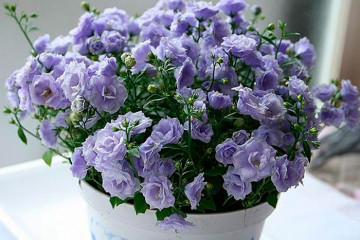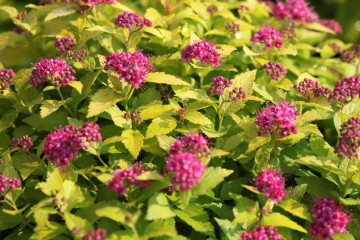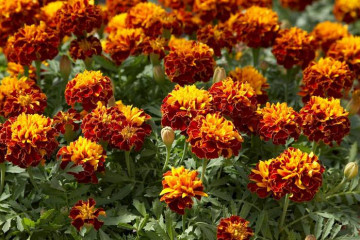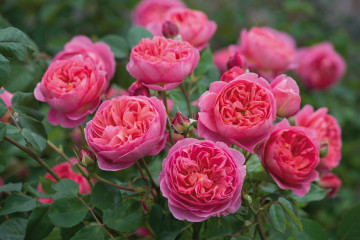Caring for roses in the summer in the country in the open field
Content:
The Rosaceae family, to which the garden rose belongs, includes more than 350 species and varieties. These beautiful flowers can grow in completely different conditions - from the Arctic Circle to the subtropics. More than 200 species are actively grown by flower growers in temperate climates; with proper care, fragrant roses bloom all summer. These plants cannot be classified as capricious, but there are certain requirements for caring for them. This is especially true for hybrid varieties. Many novice flower growers will probably find useful information on how to care for roses.
Outdoor garden rose care
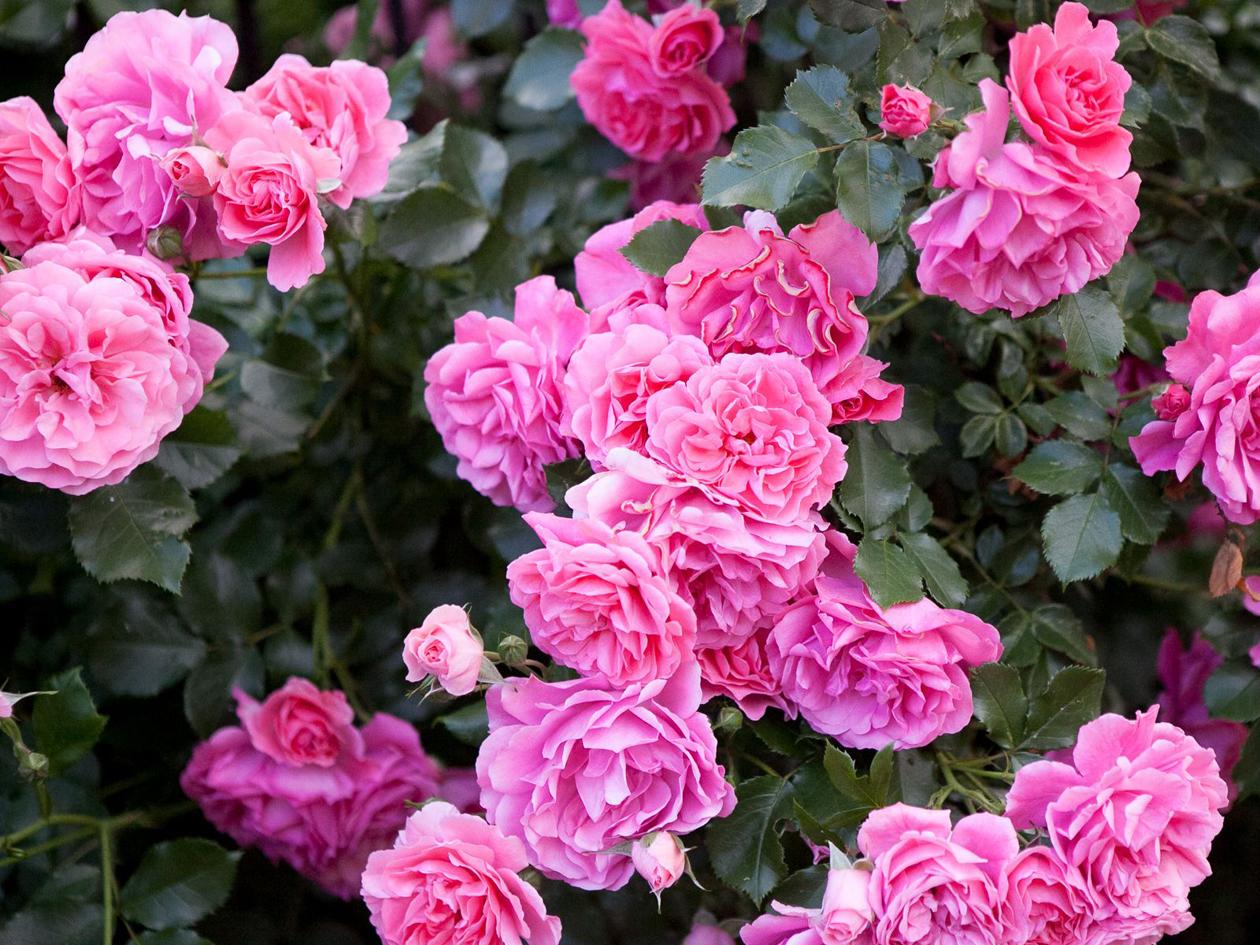
Blooming roses - decoration of the site
Most varieties of roses thrive outdoors, and some can even hibernate without shelter. Depending on the variety, it is necessary to choose the right place for planting a flower and provide it with full care in the future.
Care activities include several points:
- Watering.
- Mulching.
- Loosening.
- Weed weeding.
- Spraying.
- Top dressing.
Each of these points is important and the requirements that apply to roses should be strictly followed.
In relation to the soil, roses grow successfully on chernozems, light loams and sandy loams with a good structure and a high content of organic matter. If the soil on the site does not meet this requirement, then it must be improved. For heavy soil, it is important to add sand and humus during autumn digging.
Shelter for the winter
This point is worth considering in a little more detail. The safety of plants depends on the quality of the shelter, but it is equally important to remove it in time and carry out a number of activities that are relevant at this time.
Roses are heat-loving plants. They are prepared for overwintering in advance, namely:
- create conditions for the ripening of shoots;
- stop feeding with nitrogen in the second half of summer;
- reduce the frequency of watering.
Thus, the plants gradually move into a quieter phase and prepare for wintering. In October, before the shelter, unripe shoots and flowers should be cut off, then before the onset of frost, the bushes should be spud to a height of 10-12 cm.
With the onset of stable frosts, climbing roses are removed from the supports and laid on the ground, and the standard ones are bent to the ground and pinned. Leaves, spruce branches, peat can be used as a shelter. For additional insulation, a non-woven structure is constructed.

Roses should be provided with shelter for the winter.
In early spring, as soon as the snow melts, the plants are freed from the shelter. Do not open roses completely right away - a sudden opening can harm them. As it warms, it is necessary to gradually, layer by layer, remove the insulation. After the complete release of the plantings, pruning is carried out, in which all damaged and diseased shoots are removed.
Summer rose care for abundant flowering
The natural desire of every rose garden owner is a lush bloom throughout the summer.Only healthy plants are capable of this, and therefore it is necessary to know how to care for roses in the garden and provide them with favorable conditions for growth. Only under this condition will the rose garden turn into a beautiful blooming carpet.
Landing
Correct planting of roses in open ground is half the success. Planting errors are difficult to correct and even the most careful care may not save the situation. Therefore, the item on how to plant roses can be considered the first in the list of care measures.
Planting plants in open ground is started in spring or autumn. It is better to plant heat-loving street varieties in the spring, or in the fall so that they get stronger before the onset of cold weather. Landing is carried out step by step:
- Planting pits are prepared. Their size should exceed the size of the root system along the entire perimeter by 5-6 cm.
- The extracted soil is mixed with ash and rotted manure or humus in a ratio of 3/1/1.
- A drainage layer of fine gravel or broken brick is poured onto the bottom of the pit.
- Pour 1/3 of the prepared soil on top with a mound.
- A seedling is placed and watering is carried out.
- Cover with the remaining earth and lightly tamp the surface.
- Repeated watering is carried out and the surface is mulched with peat.
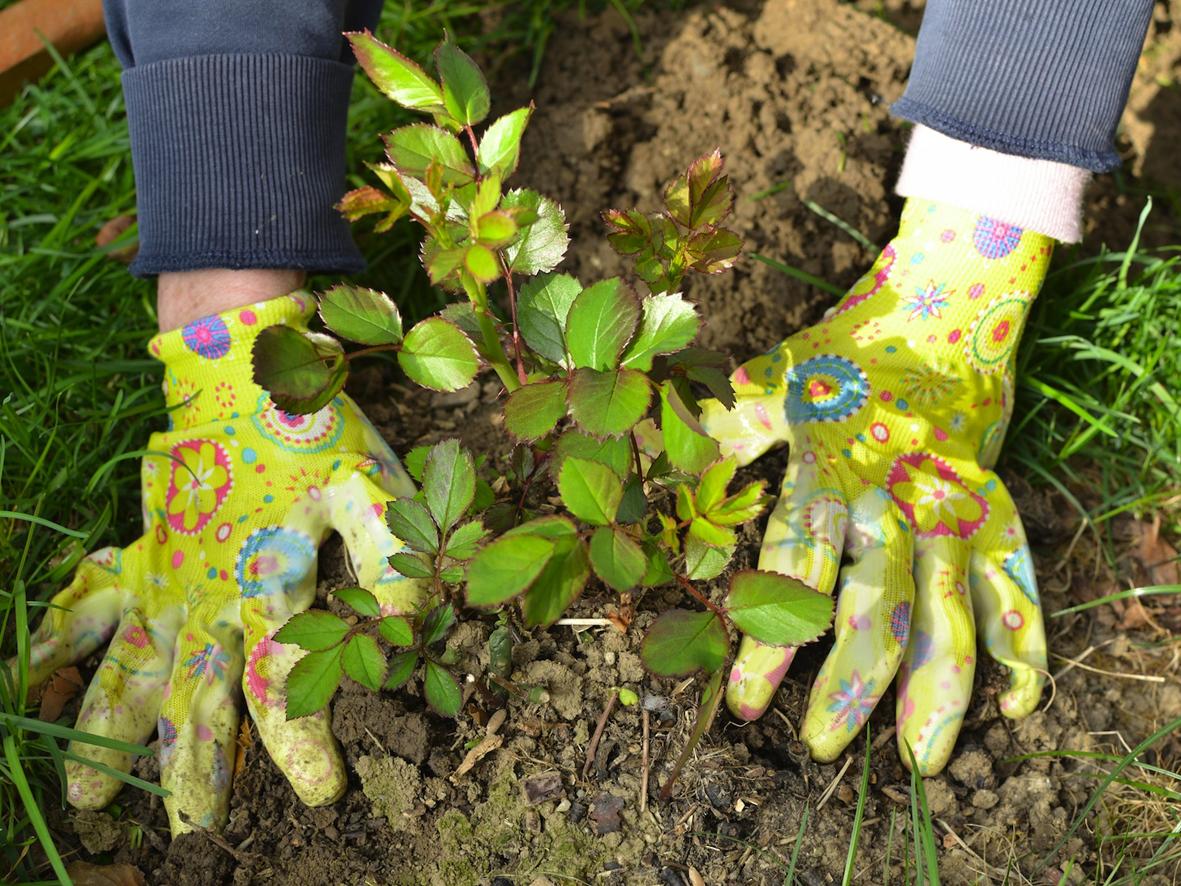
There are certain rules for planting roses.
The first time after planting, regular watering should be ensured for successful rooting. If the planting was carried out in the fall or in August, then before the onset of cold weather the seedling must be carefully covered. This rule also applies to winter-hardy varieties, which in adulthood can winter without shelter.
Mulching and loosening
Roses are demanding on moisture and air permeability of the soil. To minimize the labor costs of moistening the soil, especially in regions with an arid climate, the soil around the plantings is mulched.
This procedure can be compared with top dressing, if peat, humus or dry rotted manure is used as mulch. In this case, nutrients from organic matter will gradually penetrate into the soil and enter the roots, which will serve as an additional source of nutrition.
This procedure is carried out regularly, starting from the moment of landing and ending with preparation for the winter shelter. The soil should be loosened 3-4 days after watering. Simultaneously with loosening, it is necessary to weed.
Top dressing
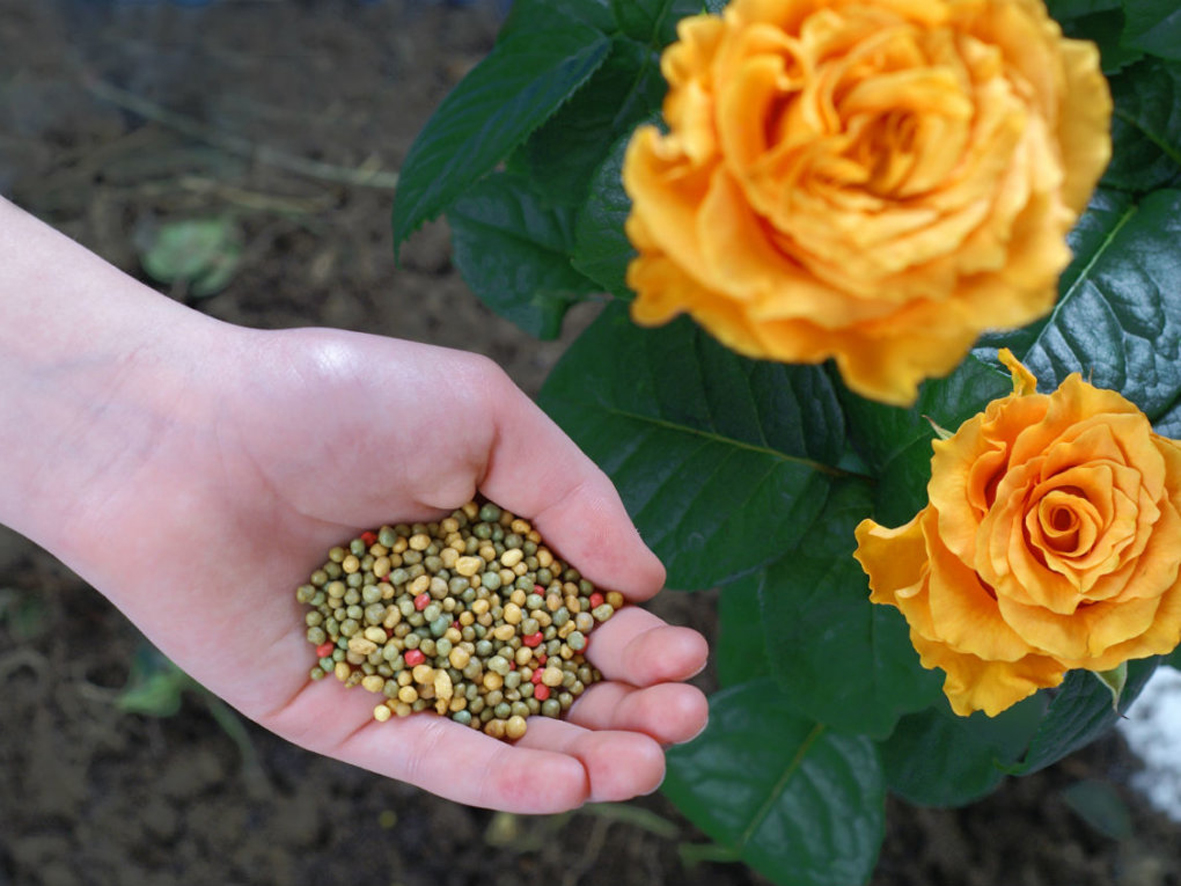
For abundant flowering, fertilizing is necessary.
Regular feeding is very important for abundant flowering. Alternately, at each stage of development, either organic matter or mineral fertilizers are used, but at the same time they should be alternated.
The approximate sequence of fertilization is as follows:
- In early spring, after pruning, horse manure is applied (5 kg per 1 m2) or low-lying peat (4-5 kg per 1 m2).
- In the first decade of May, they are fed with ammonium nitrate or other nitrogen fertilizer (20-30 g per 1 m2).
- In June, watered with mullein solution (1/10).
- In late June - early July, a complex mineral fertilizer is used (20 g of nitrogen, 30 g of phosphorus, 30 g of potash per 1 m2).
- In September, fertilize with a mixture of phosphorus and potash fertilizers (20 g and 40 g, respectively, per 1 m2).
The alternation of organic and mineral fertilizers allows the plants to be provided with nutrition as much as possible. Roses will actively build up vegetative mass and bloom profusely only if they are properly cared for.
Watering features
With regard to watering, the most important period is the rooting of young seedlings. At this time, the soil should be moistened every 3-4 days. And in dry weather more often.
Adult plants are watered every 7-10 days. Watering should be related to fertilization.Both mineral and organic dressings are applied only to wet soil, but not immediately after watering, but after 1-2 days.
If the soil under the rose bushes is mulched, then the area can be watered less often. A layer of mulch retains moisture in the soil and dries out much more slowly.
Spraying
Spraying activities can be divided into two groups that perform different functions. Namely:
- Treatment for the prevention of diseases and pests.
- Foliar dressing with mineral fertilizers.
Many growers neglect foliar dressing, but in vain. This fertilization method is very effective, especially in summer. After such a procedure, the number of buds increases, and the blossoming flowers retain their freshness longer and do not wither both on the bush and in the vase.
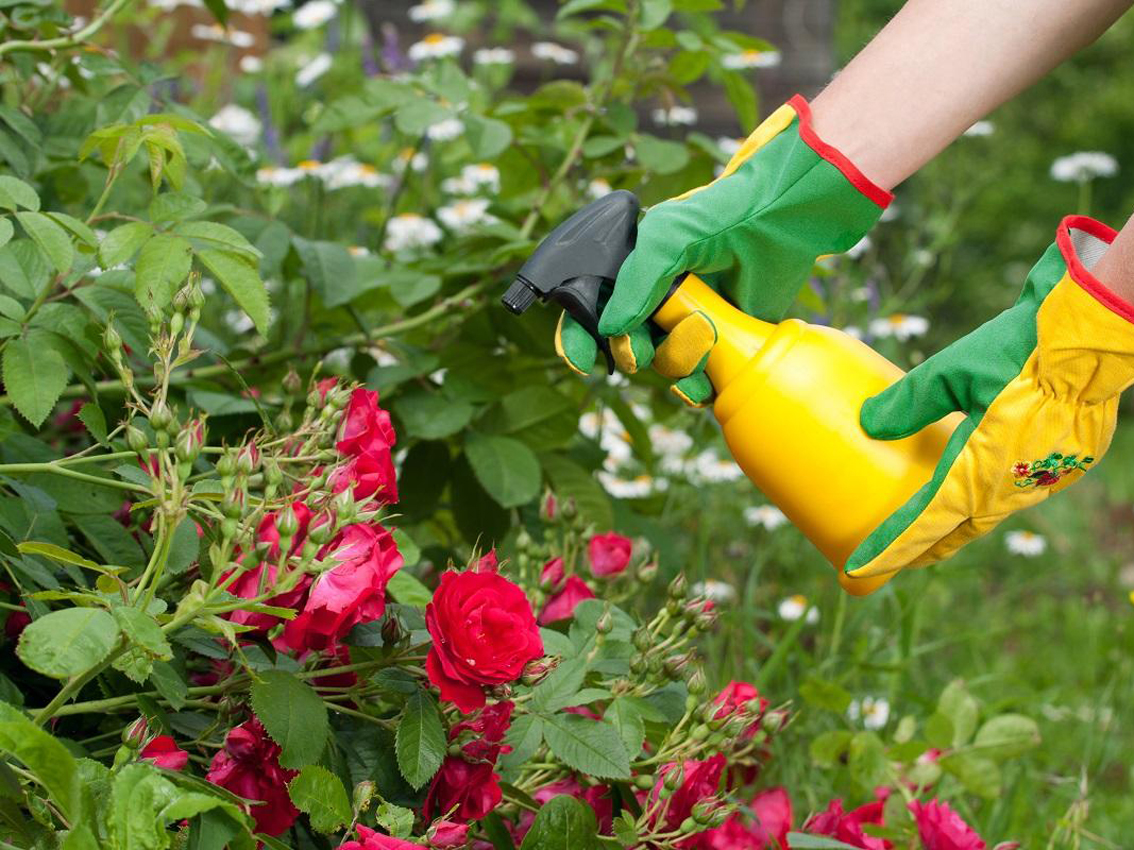
Foliar dressing should not be neglected.
For foliar dressing, you can use a complex mineral fertilizer (1 tablespoon per bucket of water). Ash can be an alternative to mineral dressing. For spraying, an ash solution is prepared by pouring 1 tbsp. ash 10 l. water and bring to a boil. Then the liquid is infused and sprayed with a rose solution. In addition to nutrition, the ash solution acts as a preventive measure against aphid infestation, which very often damage roses.
At the very beginning of bud formation, you can also fertilize the leaf. Such spraying is intermediate between the main stages of fertilizing. Phosphate-potassium fertilizer is used, which is prepared as follows:
- 110 g superphosphate is poured into 1 liter. hot water and insist 2-3 hours.
- Filter the solution through cheesecloth.
- Add 20 gr. potassium nitrate and mix thoroughly.
The solution should be used immediately after preparation. It should be applied generously so that the leaves are completely wet.
Protection against diseases and pests
Roses suffer from pest attacks quite often, so their cultivation is unthinkable without regular preventive treatment. The most common rose pests include:
- aphid;
- lithover;
- spider mite;
- rose-colored sawfly;
- bronze;
- weevil.
An important role in the fight against these pests is played by the spring treatment of plants with insecticides. This procedure is carried out after removing the shelter and trimming, most often this is the end of March. For spraying, use a 1% solution of copper sulfate or a special ready-made preparation designed specifically for the treatment of roses.
After the plants start growing and before budding begins, if necessary, you can carry out this treatment again.
Diseases of roses and methods of struggle
The most common rose diseases are powdery mildew, black leaf spot and rust. Many varieties of modern breeding are very resistant to them, but it is also desirable to process them for prevention.
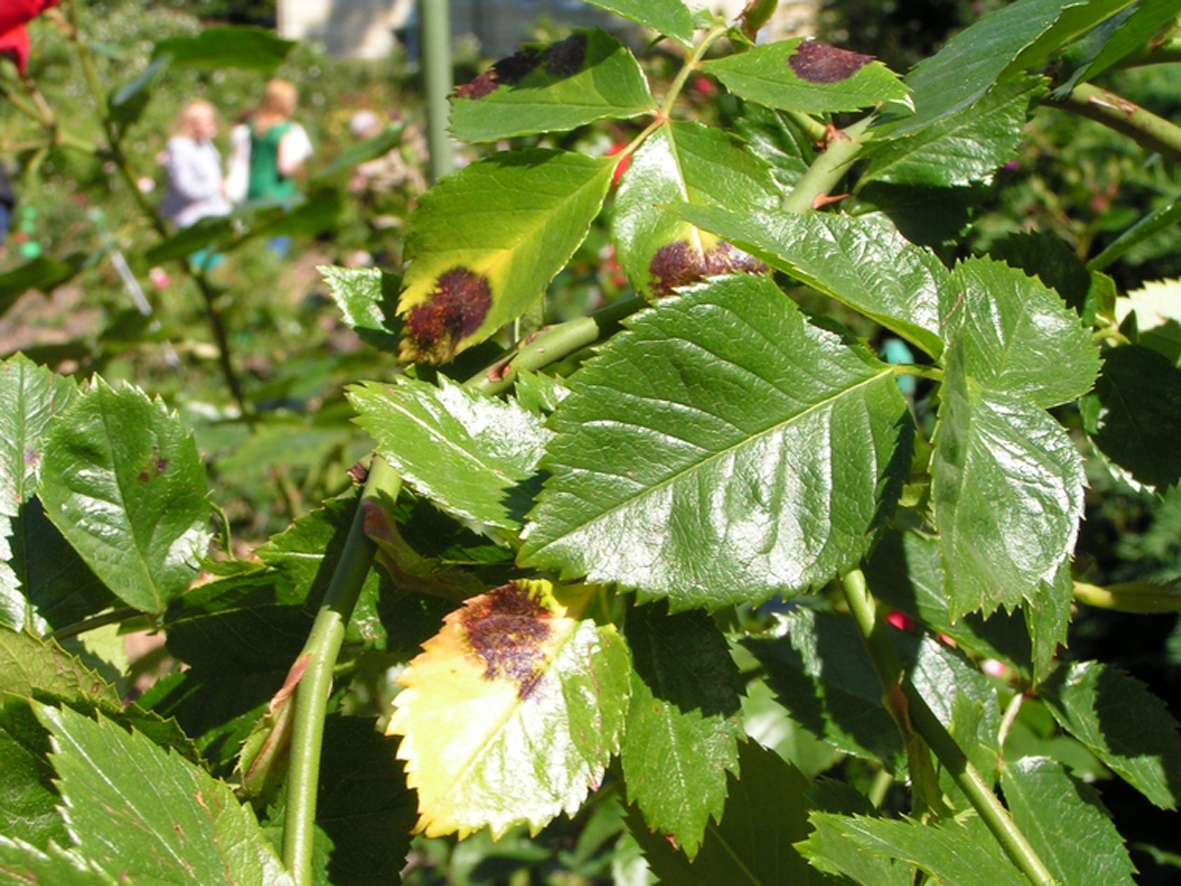
Black leaf spot often affects roses
You can use ready-made preparations and they are the most effective, but this option is hardly suitable for adherents of organic farming. For such gardeners, there are folk methods of combating rose diseases. Here are some tips for this:
- For powdery mildew, you can use an ash and manure mixture, the name of which already speaks of its composition. For this 220 g of ash and 1 kg. manure is poured into 10 liters. water.The mixture is infused for a week, then stirred, filtered and sprayed.
- At the initial stage of rust development, euphorbia helps. It is necessary to lubricate the spots on the leaves with its juice. For spraying, milkweed infusion is used. For this 2 kg. crushed plants are poured into 10 liters. water and insist for a day.
Do roses need pruning in summer
For all varieties, the rule applies - wilted flowers should be removed. This must be done throughout the flowering period to stimulate the formation of new buds.
Also in the summer, formative pruning for climbing roses and sanitary pruning for all species and varieties of plants are carried out. Also, at the end of summer, the bush should be thinned to prevent its thickening, as this will lead to a halt in the development of young shoots or the development of rot.
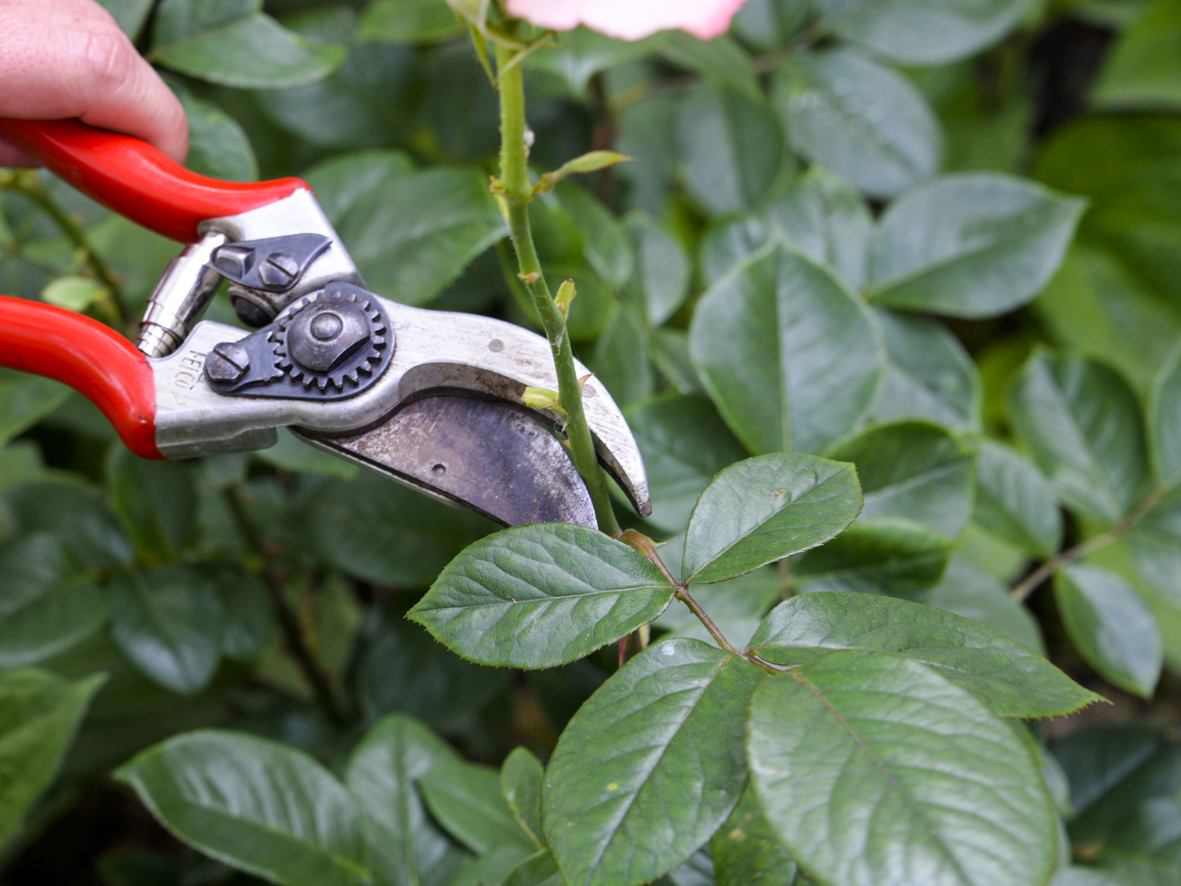
Pruning is a necessary agricultural technique
General rules for pruning roses
Pruning of roses is carried out in accordance with their belonging to a certain group. Conventionally, 3 main groups can be distinguished:
- Hybrid tea. The bush is formed in the shape of a ball. During the period of active growth, shoots are removed minimally, since the buds of this group are formed on young shoots of the current season. The shoots are shortened so that their length is 15 cm for young plants and 20 cm for older specimens. Lateral shoots are cut so that 3-4 buds remain on them.
- Floribunda. These varieties require intensive pruning. But different shoots are cut in their own way - some are shortened to the maximum, and the rest, mainly annuals, only by 1/3 of their length. The old lashes, which are located in the center of the bush, are completely cut out.
- Climbing. For this group, very gentle pruning is used. In the fall, only the damaged lashes are removed and the withered flowers are cut off, and in the spring they carry out sanitary pruning and shaping, minimally shortening the lashes.
For roses, pruning is a very important and necessary agricultural technique. Only if the rules for its implementation are observed, it is possible to achieve active flowering of plants in summer. In addition, if you neglect pruning, then over time, a varietal flower will turn into an ordinary rosehip.

Without pruning, a rose can turn into a rosehip.
The variety of varieties of roses allows you to grow them both in the country and as a home flower in a pot. Caring for roses in the garden includes a number of activities, namely watering, feeding, spraying and pruning. It is equally important to properly plant young seedlings. A mandatory agricultural technique for these plants is pruning, which is carried out in stages from early spring to autumn. Only if you follow all the rules of grooming can you achieve an active and beautiful flowering of roses in summer.
